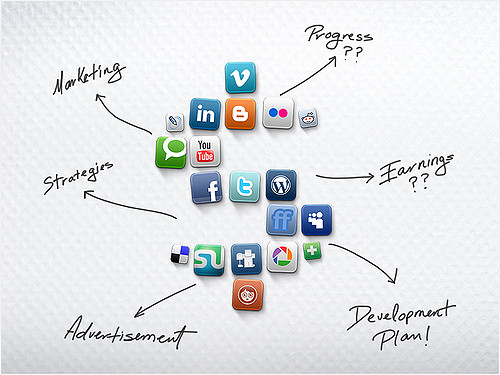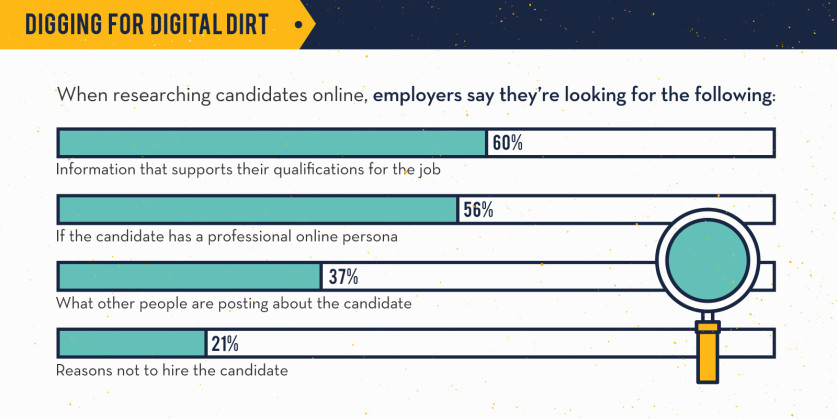
by Fronetics | Mar 24, 2016 | Blog, Marketing, Social Media, Supply Chain

These four supply chain companies constantly post fresh, quality content to their social media accounts.
When it excels at social media, a company’s opportunity for growth is as vast as the web itself. Today, even small businesses can compete shoulder to shoulder with their biggest competitors if leveraging social media properly.
It is estimated that for every 5 minutes people spend online, 1 minute of that is spent on some kind of social media network. And most of your customers are on social media — statistics indicate that more than 79% of adults in the U.S. use social media each day. As the popularity of sites like Facebook, Twitter, Instagram, and company blogs continues to grow, it is vital to utilize these tools to your own marketing advantage.
When you think of social media masters, you may not think of companies in the supply chain industry. But there are a few excellent examples, and much can be learned from what they do. Here are four supply chain companies that excel at social media and the reasons why they stand out above the crowd:
1) Cerasis
Cerasis, a top freight logistics company and truckload freight broker, excels at social media because their content is fresh, posted daily, and of high quality. Simply put, they create engaging, informative content and are consistently active across all of the major social networks.
2) Kinaxis
Kinaxis, a global company offering advanced supply chain management systems to customers in a variety of discrete manufacturing industries, offers in-depth blog posts and is consistently active in social media channels such as Twitter, Google+, and LinkedIn.
3) Transplace
Transplace, a provider of transportation management services, posts informative articles and incites topics of conversation on Twitter several times per day. The company is active across all social media platforms, including their own YouTube channel.
4) UPS Longitudes
Longitudes is a blog with insights on the trends reshaping the global economy by United Parcel Service, a global leader in shipping. The blog also engages true thought leaders on topics ranging from trade to transportation and ecommerce to emerging markets. Posts are consistently new, innovative, and informative. Longitudes also has its own social media accounts, separate from UPS’s primary accounts, which distribute the blog’s content and engage in related discussions.
Why do these four supply chain companies excel at social media? Here are three commonalities that help these businesses rise above the rest:
Consistent daily posts and content
Having consistent, reliable, fresh social media posts is essential. The more active you are, the greater your outreach to potential new customers.
Think of it this way: search engines pick up on social media activities — like when someone shares content from your website on Twitter or Facebook, for example. Search engines use this to weigh the relevancy and validity of your website and your company. So, fresh daily or weekly content gives people a chance to read and share every time you publish a blog post, ebook, buying guide, case study, testimonial, and other interesting content to your social media accounts. Your marketing efforts reap the benefits of better search engine rankings as a result.
Engaging readers
You want readers to connect and engage with your social media posts. Every time they leave a comment or share or like a post, your social media presence — and your digital footprint — grows.
Quality content
Posting anything just for the sake of posting is not a good social media strategy. Content that is boring and basic will not help your business grow. Content needs to capture the interest of readers and engage them to read, share, and follow your business. Posts should be timely and relevant. This is what builds your following and your brand and generates new customers.
With social media you can find new customers and fans, connect with existing customers who can help spread the word about how great your product or service is, and drive more traffic to your website, which creates new avenues into the digital realm of marketing, company branding, and lead generation. The most successful companies today work daily to improve their social media content and reap the benefits of consistent, quality content marketing.
Related posts:

by Fronetics | Mar 3, 2016 | Blog, Content Marketing, Marketing, Social Media, Strategy

Source: Rosaura Ochoa | Flickr
Here’s how marketers can launch a B2B social media program that grows business.
A recent Harvard Business Review article discloses that a number of B2B CEOs still believe social media isn’t right for them, that it’s a tool for the B2C segment. In reality, many B2B marketers successfully leverage social media to engage potential customers, gather market intelligence, build brand awareness and reputation, discover and intercept customer problems, and influence purchasing decisions before sales calls are ever made.
In short, if you are not in the B2B social media game, you are missing out on enormous business opportunities.
Getting started with social media can seem like an intimidating task, especially if your C-suite is skeptical of the benefits. Here are six steps to launching a B2B social media program that will grow your business to its full potential.
1) Speak in the right terms.
Convincing management that you want your team to spend more time on social media to gain “followers” or get “shares” might be a hard sell. To win support, focus your argument around the factors that are most important to them. Lead generation, lead nurturing, conversions, sales, ROI, profits: this should be the vocabulary with which you approach this conversation.
2) Create a strategy — and put someone in charge.
Only 11% of companies without a documented content marketing strategy find their efforts to be successful, compared to 60% of companies with a strategy in place. And that number rises to 86% when the company designates someone to lead the strategy. Working with an experienced marketing consulting firm, like Fronetics, you can develop an inbound marketing strategy that aligns with your business objectives. And whether someone on your team heads up execution or you outsource that responsibility, the leader should continually monitor analytics and tweak the strategy accordingly. Which brings us to…
3) Determine which analytics to track.
In the B2B world, it’s not about shares, likes, or impressions, though those numbers speak to your brand exposure. (Read more about so-called “vanity metrics” here.) Leads generated, conversion rates, sales, and ROI are going to be the things you’ll want to track. If you have a good, flexible strategy in place, these metrics will help you adjust your efforts to ensure you’re achieving your business objectives.
See: The Six Marketing Metrics Your Boss Actually Cares About.
4) Develop quality content.
Twenty-seven million pieces of content are shared every day — and a large portion of it is crap. A social media presence could be pretty pointless unless you’re using it to push content that is original, high quality, and representative of your brand. One of the biggest mistakes B2B companies make is using social channels to push a sales pitch. You’ll quickly lose your audience, who is turned off by a strong sales pitch. Social media is about engaging your audience, building brand awareness, and offering valuable information.
See: Three Elements of Good Content.
5) Decide which channels are right for your business.
Who are you trying to reach, and what are you trying to tell them? These are good questions to ask when trying to determine which platforms will comprise your social media program. There’s a wealth of information out there about which channels are used by whom and when. You’ll also want to choose channels that you’ll be able to maintain regularly and which play to your strengths. As an obvious example, if you don’t have the capability to make videos, YouTube probably isn’t for you. Remember, you’ll likely want to work through several different channels to reach a maximum number of potential customers.
See: Which Social Media Channels Should Your B2B Business Use?
6) Follow your competitors.
Following your competitors is a great way to stay up to date on what they’re doing, especially if you don’t have a ton of time or money for competitive research. And when I say “follow,” I don’t mean “copy or imitate.” I mean subscribe to their blogs, engage with them on social media, and like and share their content that you find meaningful for your audience. This way, you become part of the industry conversation happening online, and you know exactly what your potential customers are seeing from (and how they’re reacting to) your competitors.
See: The Role of Social Media in Supply Chain Intelligence.
Related articles:

by Fronetics | Feb 15, 2016 | Blog, Marketing, Social Media, Strategy

When you are posting on social media could be as important as what you’re posting.
Timing is everything, and that statement especially holds true when it comes to posting content to social media. If you are sending out your message and nobody is there to see it, you are that proverbial tree falling in the forest; you did not make a sound. Your post had little to no impact.
So, even if you are putting in the time and effort to craft informative blog posts, tweets with just the right message, or Facebook posts that inspire more than just page likes, you still are not getting the most exposure you can out of social media.
Data that delivers results
According to research by social media scientist Dan Zarrella, when you are posting your content can be almost as important as what you are posting. Luckily, there is an ample amount of analytical data out there regarding optimal times to post on Facebook, Twitter, LinkedIn, Pinterest, and Instagram.
For example, looking at broad-based Twitter engagement, research suggests that users go up by 30 percent on weekends, speculatively because more people are on their computers, smartphones, and tablets during their free time. On weekdays, this peaks at 4 p.m. EST, perhaps as people check into social media as the workday begins to wind down and they are seeking a diversion.
Some studies suggest that Twitter use often peaks slightly earlier, between 1 and 3 p.m. on weekdays, and this might be attributed to people who take an extended lunch break.
LinkedIn studies show that the optimum times to post content are Tuesday through to Thursday during normal work hours. Also noted: Tuesday 10 to 11 a.m. is known to get the most clicks and shares.
When it comes to Facebook, another marketing study suggests that there is quite a wide range of variables, and it is really based upon your audience. But, in general, the best time to post on Facebook is 3 p.m. on Wednesday. Other popular times include 1 to 4 p.m. on Thursdays and Fridays, and lunchtime (12 to 1 p.m.) on weekends.
There are poor times to post on Facebook, too, such as weekends before 8 a.m. and after 8 p.m., according to SurePayroll’s research.
Research supports that B2B content generally performs 16% better during typical business hours, while B2C content performs 17% better on weekends.
Your (personal) optimal posting time
But, the problem with these suggestions is that they are just statistical generalizations of when might be the optimal time for posting content. What you need is analytics that are specific to your particular followers. Your audience maybe a different demographic than those represented in these studies, and when they are reading, sharing, or retweeting may actually surprise you.
You can access personalized data regarding the social media habits of your readers and followers through analytic programs like Google Analytics and sites like Tweriod. There are a wealth of available free tools, which provide valuable insight regarding your audience.
Here are a few to consider:
- Tweriod is a free Twitter tool that helps you know the best time to tweet. The free analysis will analyze up to 1000 of your followers. Tweriod is not part of Twitter but rather is something you may access to better understand your followers’ schedules and interests, like what they have retweeted.
- Followerwonk can help you to individuate your potential Twitter audience by learning not only who follows your competitors, but who commonly retweets their content. You can also look at your own personal audience and discover what content they like, share, and maybe even link to from other posts, as well as when they are most active on social media.
- Facebook Insights tells you the best times and days to post content by accessing your page’s insights in the posts sections. In the graph section for “When Your Fans Are Online,” you can see the days and times when your fans are using Facebook. This data is constantly updated.
- Google Analytics provides insights, analytics, and data regarding your website, and it lets you do more than measure sales and conversions. It also gives insights into how visitors find and use your site, what they are clicking on, and how to keep them coming back.
Many people still play a guessing game when it comes to deciding the best time to post their content for the most impact. But, studies suggest the average life of a tweet is only about 18 minutes. So, if you tweet something during an inactive period for your Twitter audience, you are probably wasting your time.
Posting the right content, at the right time, can make the difference between getting valuable comments, shares, and clicks on your links, and it can provide a myriad of valuable new leads.
Related posts:

by Fronetics | Jan 27, 2016 | Blog, Leadership, Marketing, Social Media, Strategy
Should employers be monitoring or censoring employees’ social media?
 Censorship is always a hot-button issue, and, when combined with social media, things can heat up even more. The topic is debated in law school classrooms, at dinner parties, and in courtrooms. What should be shared and written on social media? Should companies censor what their employees post?
Censorship is always a hot-button issue, and, when combined with social media, things can heat up even more. The topic is debated in law school classrooms, at dinner parties, and in courtrooms. What should be shared and written on social media? Should companies censor what their employees post?
The waters still seem murky. Many companies don’t have policies around social media, but, with over 70% of online adults using Facebook, and the Internet-crazed Millennial generation now outnumbering Baby Boomers, they should look into putting some guidelines and policies into place.
Who’s Digging?
Many companies, up to 60%, now research candidates according to Career Builder. Up to 48% of companies who have researched candidates have found reasons not to hire them. According to the site, reasons range from provocative photos, references to drug or alcohol use, badmouthing a former employer or colleague, poor communication skills, and discriminatory comments.

Source: Career Builder
A New Generation
Although the retiring workforce does use the Internet (46% of those 65+, and 65% of those between ages 50-64), their numbers cannot compare to users in the younger, upcoming workforce (90% of those between 18-29).
The Millennial generation was born and raised in the digital age. Many of them have never heard of the Dewey Decimal System or know a life before cell phones. Their digital devices, and the Internet, have been their best way to research and connect. They are accustomed to throwing political views, photos, and personal experiences — good or bad — out into the cyber world. Many have already had the experience of poster’s regret, which might have taught them a lesson, but may also have blunted the idea of permanent mistakes. If one can delete a post and apologize, why not post away and worry later?
To Monitor or Not Monitor, That is the Question
Thinking carefully about what your expectations are of employees, and addressing those expectations in writing, is an important step to consider.
We assume that most employees know they shouldn’t post anything that damages the reputation of the company, its products, and employees, but it may be best not to assume. A case study in a recent Harvard Business Review provides a perfect example of what can happen if policies aren’t put into place.
In his Time piece, “Why Monitoring Employees’ Social Media is a Bad Idea,” author S. Kumar argues that while monitoring candidates might make sense, monitoring current employees breeds a suffocating and intrusive atmosphere:
“By allowing workers to live their personal lives without intrusion, smart businesses can make a powerful statement; namely, that they accept them for who they are, treasure their professional contributions to the company, and want them to be happy and fulfilled outside as well as inside the office. This, in turn, would inspire loyalty and boost productivity in the workforce, and make those companies more profitable.”
However you feel about the topic of monitoring, and even censoring, it’s important to be clear with employees about expectations. A general statement about employee behavior and representation of the company might be enough to instill deeper forethought when employees post, comment, and like.
Do you monitor your employees’ social media accounts? Do you have a policy in place that covers personal social media activity?

by Fronetics | Jan 11, 2016 | Blog, Content Marketing, Logistics, Marketing, Social Media, Strategy, Supply Chain

Over the past year we have helped many clients both develop and execute social media strategies. We have also disseminated information on how companies can use social media as an effective business tool.
Here are the top 10 social media articles from 2015:
Leads are essential to the growth of your business, and your marketing strategy is built around finding and connecting with leads. So when 92% of all marketers indicate that their social media efforts have generated more exposure for their businesses, you should take note and make social media part of your prospecting strategy. Read the full article.
The supply chain makes the world go round. In order to be one of the leaders in the chain, it’s important to remember that internet users make up nearly half of the world’s population and that social media is on the rise. Don’t miss that boat. Read the full article.
Many transportation and logistics companies think about social media and how to use it, but cite a lack of time as a reason they haven’t explored the various platforms. Thinking about how social media can work for your logistics or transportation company is the first stop towards progress. Read the full article.
Social media is an ideal marketing platform for small businesses because it can be relatively inexpensive but have a high impact on growth. With a targeted strategy in place and a little time, your company can cultivate your brand, engage with customers, and form business relationships. And because small companies can be nimble, you can continually adjust your strategy to ensure the return on investment keeps paying off. Two companies that have seen social media to be effective: Coyote Logistics and Transplace. Read the full article.
The social economy is estimated to be $1.3 trillion U.S. dollars annually. Social media is more than a collection of personal commentary, photos, and inspirational quotes. Increasingly, social media creates an opportunity to gather information, and social media is becoming a useful tool for businesses to connect with other businesses and clients. Although Facebook is notorious for gathering information, social media companies are not the only companies who can gather intelligence. Read the full article.
Offering unparalleled access to leads and face to face communication with prospects and customers, trade shows prove to be a successful marketing strategy for many companies. But is your company making the most of trade shows? Companies that integrate modern digital communication practices into tired trade show routines are likely to increase lead to customer conversion rates while shortening lead and sales cycles. Read the full article.
Companies within the logistics and supply chain industries have been slower to participate in social media than other industries. The primary reason being because of a lack of understanding of what social media is and the role it can play for business. Unfortunately, companies who do not participate in social media miss out on opportunities – and revenue. Read the full article.
Using the information and intelligence gathered is essential. There is; however, another critical element: engagement. Engagement is a differentiator. Without engagement you are a lurker. You don’t want to be a lurker. Read the full article.
Social media has been found to be a strategic tool for logistics companies. Check out our infographic. Read the full article.
Through the use of social media you can enable consumers to make more informed purchase decisions. Additionally, you can use social media to answer questions and better educate consumers on how to use your product thereby reduce no fault found returns. Read the full article.
Social media is an incredible tool; however, for it to be effective it must be driven by strategy, be consistent, and must have someone managing the execution. At Fronetics, our social media strategists distribute content, curate content, engage your target audience, and monitor your social networks. We develop a social media strategy that aligns with your company’s goals. We analyze your competition, classify your target audience & cultural attributes, identify the influencers in your industry, recommend platforms, detail best engagement practices, create social media schedules, and identify specific tactics that deliver results. Through the proper execution of social media, your brand is given a voice and personality, and becomes more accessible to your target audience.







